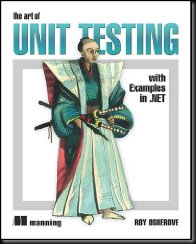The Art of Unit Testing – The Book
I have finished reading the book and wanted to write a short review, but  the best I could come up with is a list of cons and pros. Lame, I know, but this will give you a hint at least.
the best I could come up with is a list of cons and pros. Lame, I know, but this will give you a hint at least.
pros
- Smooth introduction, complexity is added step by step
- “Strict mocks are causing brittle tests” – more than that, it causes to get into the private details of execution, rather than overall design and behaviour
- “Method strings are bad inside tests” – absolutely
- “Mapping tests to projects” – very right decision to spend time on the subject and show a right example
- One-test-class-per-feature pattern is mentioned (music to BDD fan ears)
- Writing maintainable tests – critical topic that was covered
- DRY in test code – in general I agree that an unnecessary duplication should be removed from the test code. But there’s a think line that should not be crossed – tests should be readable and maintainable. For that, duplication sometimes is necessary. This is the less evil for a bigger cause – readability and maintainability.
- Row testing is showed
- “Integrating unit testing into the organization” – a very, very useful chapter, especially if you have to pioneer the field at your work place. Personally, I wish I would read this long time ago.
cons
- Tests naming conventions
- Too much is dedicated to Stubs and manual Mocks
- Chapter 5 - Isolation (mock object) framework is explained with Rhino.Mocks Record/Playback rather that AAA that is more natural
- Note: AAA sample is showed, but after Record/Playback, which IMHO is a wrong way of teaching it. AAA is more intuitive and sticks more than the opponent.
- TypeMock promotion – Roy is working for TypeMock that is a commercial tool. He could definitely use an OSS framework to show AAA mocking framework, like Moq framework. In an absence of a free tool, I would accept TypeMock as an example, or as a part of available commercial tools. (Page 130 shows the distribution of popularity, and Rhino.Mocks with Moq are the two most popular free mocking frameworks). This was a promo for the tool… not nice.
- Note: I am not a big fan of the fluent naming TypeMock is using. Isolate.Fake.Instance<IWebService>() is two verbs that are not intuitive.
- Naming conventions for tests – both unit tests and integration tests are suffixed with a single word “Test”. I would rather distinguish and use context “Spec” and “Integration” as an example.
- One-test-class-per-class pattern – for someone who’s doing BDD this is an anti-pattern. One big test class is a smell. It leads to brutal test code that is not only difficult to maintain, but even understand from it what it is doing. Very typical to the classical TDD.
- Note: Roy has provided a tip on this, politically correctly hinting that not everything from the big heads (Meszaro in this case) is always an absolute must.
- Assertion with Extension Methods to improve tests readability was not showed at all
- Note: IMO Assert.AreEqual(found, expected) is confusing. I prefer to reveal intent with a code like result.Should_Be_Equal_To(expected);
- NO BDD SAMPLES – BAD BAD BAD. I strongly believe that just with classic TDD testing is not complete. BDD is the next step in the right direction, and skipping it entirely was a mistake.
Conclusions
If you are a newbie in TDD or just “checking it out” – go for this book, worth it. In case you already have experience in TDD/BDD, and you are doing it for a while, it will not add much to your tool belt. Either way, the book is welcomed, and I am excited that more and more of this kind of literature is becoming available for .NET developers. I only wish the next version will be written BDD style, right Roy? ;)